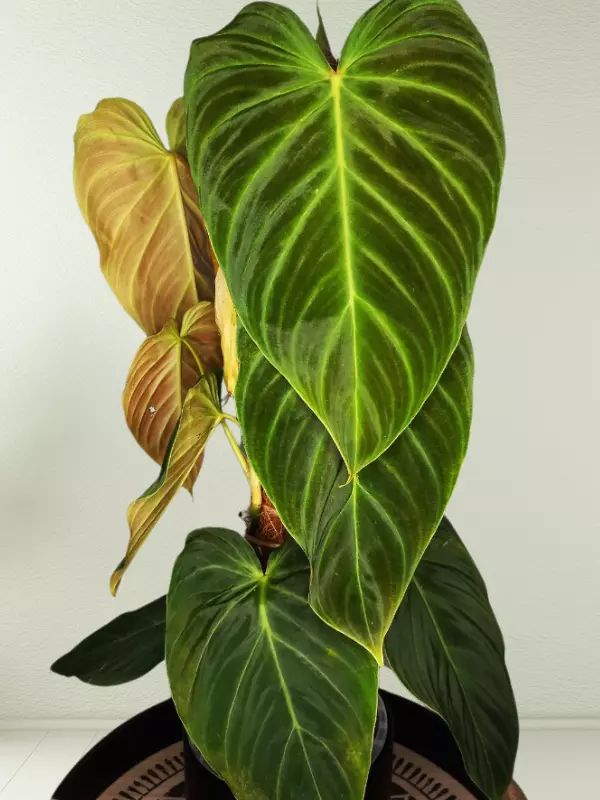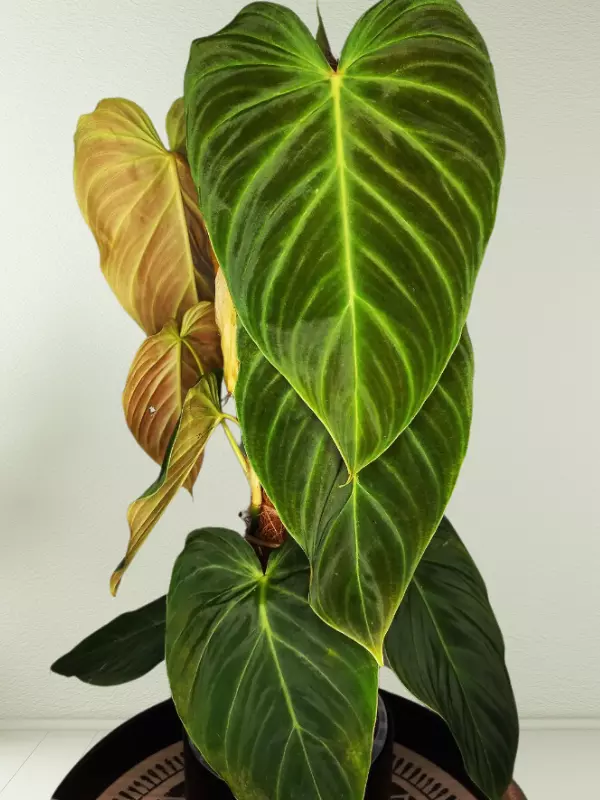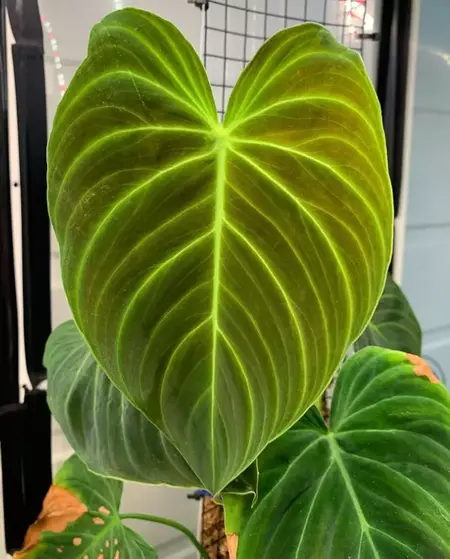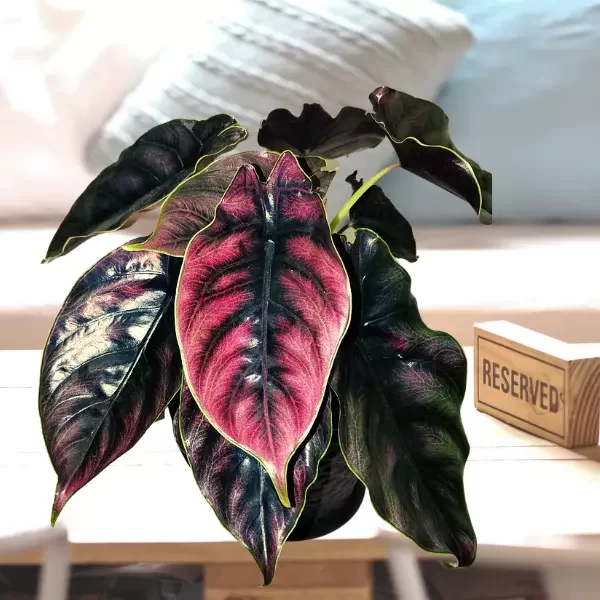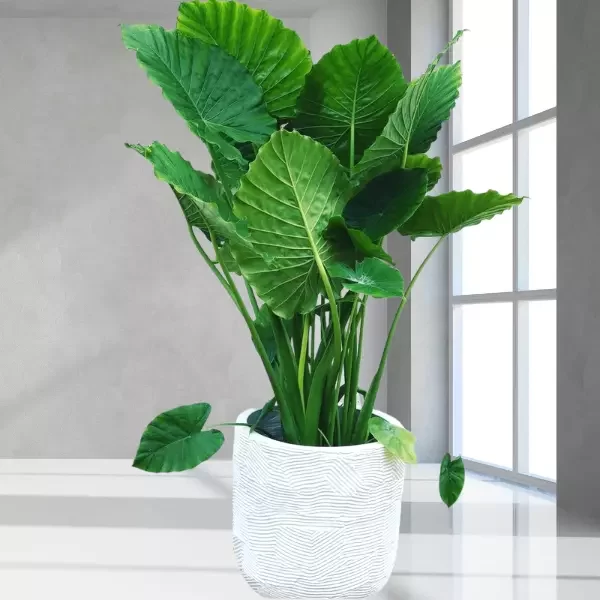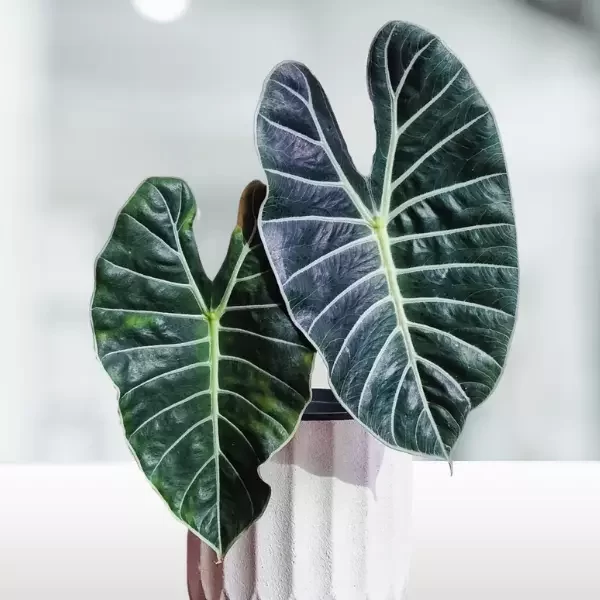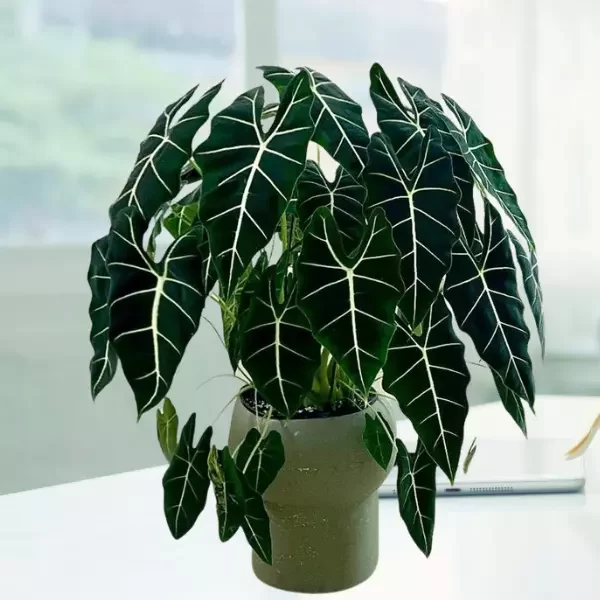The Philodendron Melanochrysum, a majestic symphony of nature, also known as the ‘Black Gold Philodendron,’ the botanical gem is a captivating pageantry of lush hues and rich textures, emanating a unique blend of elegance and resilience from the tropical heartlands of South America.
I have been wanting to get my hands on this stunning plant for a while because of its heart-shaped leaves, a stunning spectacle ranging from the vibrant chartreuse of their infancy to the depth of dark green they acquire upon maturation. Therefore, when I saw this plant at Dehner in Germany during my vacations, I jumped at it! TBH Dehner is a must visit garden center for plant lovers.
This striking transformation, mirroring the glorious journey of a gemstone, earned it the appellation ‘Black Gold’ due to the fact that the super dark mature leaves on a melanochrysum develop speckles that almost look golden. I always admired the delicate charm of its intricate, silver-hued veins, providing a captivating contrast against the luxurious, velvet-like texture of its foliage.
Melanochrysum tropical climber reminds me a lot of Philodendron Splendid with its similarly velvety dark green leaves. It is an epiphytic climber by nature, the Philodendron Melanochrysum’s remarkable endurance speaks volumes of its origin- the wet Andean foothills of Colombia. It is a perfect addition to lend an air of exotic elegance to any space.
Closely-Related Allied Species: Philodendron Verrucosum, Philodendron Mamei, Philodendron Moonlight, Philodendron Squamiferum, Philodendron Florida Ghost, Philodendron Moonlight, Philodendron Ring of Fire, Philodendron Brandtianum, Philodendron Burle Marx
Essential Products
Origin and Family
| Botanical Name | Philodendron Melanochrysum |
| Family Name | Araceae |
| Other names | Black Gold Philodendron |
| Plant Type | Epiphytic climber |
| Origin | South America (Columbia) |
| Color | Velvety dark green leaves |
| Leaf Shape | Elongated heart-shaped |
| Height | 6 to 8 feet tall |
| Humidity | 60%-80% |
| Temperature | 65°F to 85°F (18°C to 29°C) |
| Light Need | Partial |
| Propagation | Stem cutting , Air layering |
| Soil type | Well-drained, rich in organic matter aroid mix |
| Toxicity | Toxic to humans and pets |
| Repotting | Once a year |
Is Philodendron Melanochrysum easy to care for?
The Philodendron Melanochrysum, a true testament to the harmony of resilience and beauty, requires a conscientious approach to its care. Although maintaining this exquisite plant may present a moderate challenge, particularly for novice plant enthusiasts.
Melanochrysum plant hails from the rich, tropical rainforests of South America, and thus, craves environments that echo its natural habitat. High humidity levels, warm consistent temperatures, and bright, indirect light form the backbone of its care requirements. The plant thrives in well-draining, nutrient-rich soil and appreciates regular, balanced fertilization. Vigilant monitoring of its watering needs, coupled with proactive pest and disease management, goes a long way in maintaining its health.
Regular fertilization with a water-soluble, nutrient-rich formula stimulates growth while grooming and support for its vines to maintain their enchanting magnetism.
With this care, the Philodendron Splendid unveils its verdant magnificence. Let’s delve into the care details of this alluring plant.

Bringing Melanochrysum to home
The new plant you bring home can be a carrier of pests and diseases. It is essential to quarantine your new plant for two weeks before introducing it to other indoor plants to protect them from contamination. In case your new plant is pest infested, there are great chances that your other plants will be infected if they come in contact. Especially spider mites and Meally bugs infestation spreads really quickly among the plants and becomes a bit of a challenge to control.
Carefully inspect the whole plant, especially the leaves, as pests feed on the leaves lower sides. Moreover, it is always a great practice to shower your plant when bringing it home to eliminate dust and any potential pests.
For precautionary measures, apply neem oil or spray the pesticide on the leaf surface if you notice any pest invasion. My routine is to spray my new plants with Instant Plant Protection tablets before putting it with other plants and it has saved me the trouble of having pest infestation many times over the years.
After two weeks, if the plant doesn’t show any pests and disease symptoms, place it in a bright, humid area among other plants to thrive happily indoors.

Watering
The Philodendron Melanochrysum requires a thoughtful hydration balance to sustain its sumptuous foliage. This tropical specimen thrives when its thirst is quenched correctly, replicating the moist environment of its natural habitat.
During the warmer months, the Melanochrysum has increased water demands. As a general guideline, watering once a week should suffice. However, in the colder months, reduce the watering frequency to once every two weeks or when the top inch of the soil is dry. The decreased rate compensates for the slowed metabolic processes during winter.
Overwatering this botanical gem can lead to dire consequences, including root rot, a potentially fatal condition. Early symptoms may include yellowing leaves, a telltale sign of waterlogged soil. The plant may exhibit general wilting despite moist soil as the condition worsens, indicating rotting roots.
On the other hand, underwatering may lead to leaves appearing dull and potentially crisping at the edges. The plant might lose its signature lustre, indicating it’s yearning for a drink. Despite these signs, stumbling on the side of underwatering is more forgiving; these plants, like many tropicals, are more resilient to drought-like conditions than waterlogged soil. Use a well-draining soil mix or substrate, while you can also use terracotta pots to regulate watering.
Always remember consistency and moderation in watering are key. Overwatering is a common pitfall in plant care and is often far more detrimental than underwatering. Consider using a moisture meter to ensure you’re hitting the sweet spot of hydration. This handy tool can accurately determine the moisture level in the soil, ensuring your Melanochrysum’s roots are bathed in moisture, not drowning in excess water.


Light
Hailing from the canopied depths of the rainforest, the Philodendron Melanochrysum is a lover of bright, indirect light. This striking plant’s requirements are a delicate dance between adequate illumination and gentle shadow, mimicking the dappled sunlight of its native habitat.
While it appreciates ample light to fuel its vigorous growth and enormous leaves, the Melanochrysum does not tolerate direct sunlight well. Such harsh exposure can result in leaf scorching, turning its lush, velvety foliage into a bleached and brittle shadow of its former glory.
Indoors, the ideal placement for this Philodendron would be a few feet away from a north or east-facing window, or in a location that receives plenty of filtered light. If a spot near a brighter, south or west-facing window is your only option, consider using a sheer curtain to diffuse the light and protect the plant from intense sunlight.
It is essential to shield its velvety leaves from direct sunlight. Prolonged exposure to intense rays can scorch its delicate foliage, causing unsightly burns and irreversible damage. Signs of overexposure to light can manifest as yellowing leaves, distinct brown burn marks, and a general fading or bleaching of the usually vibrant green color.
Conversely, lacking light can hinder the plant’s growth potential and compromise its visual allure. Insufficient light may lead to leggy, elongated stems as the plant stretches toward the nearest light source to satisfy its desire for brightness. The leaves may lose their luster, becoming smaller in size. These symptoms indicate that relocating the plant to a spot with greater light accessibility or providing supplemental artificial lighting can help restore its vigor and beauty.
I cannot stress enough installing grow lights for your indoor plants if you want your plants to grow glossy, lush enormous leaves.

Humidity
Originating from the misty rainforests of South America, the Philodendron Melanochrysum thrives in conditions that mimic its humid, warm natural habitat. Adjusting your home to accommodate these preferences is key to nurturing this botanical beauty.
The Melanochrysum flourishes in high humidity levels, ideally around 60% to 80%. Without this moisture in the air, you may start to notice telltale signs of distress, such as browning leaf tips or a loss of the characteristic gloss on the foliage. In severe cases, the leaves might start to curl or droop.
If your indoor humidity levels are too low, there are several ways to increase them. Regular misting with a spray bottle can provide short-term relief, but for a more sustained effect, consider placing the plant on a tray filled with pebbles and water. The water will evaporate, increasing humidity around the plant. Alternatively, you could invest in a humidifier to maintain a more stable level of humidity.
It is a common practice out there to mist your plant to increase the humidity, but in my experience, it’s not practical. Let’s face it, firstly, misting your plant will increase the humidity temporarily, and 2ndly it’s a hectic job to mist a large group of plants frequently. I would highly suggest investing in a good plant humidifier if you own some tropical plants.
Temperature
In terms of temperature, the Philodendron Melanochrysum prefers a warm, consistent environment, ideally between 65°F and 85°F. Exposure to temperatures below this range can result in stunted growth, yellowing leaves, and potential root damage. High temperatures, especially when combined with low humidity, can cause the plant to wilt or even suffer from heat stress.
Sudden changes in temperature can be particularly detrimental, leading to shock, which can evident as wilting, dropping leaves, or stunted growth. Like many tropical plants, the Philodendron Melanochrysum appreciates stability, so avoid placing it near drafts, air conditioning units, or heating vents.
Exposure to chilly conditions can result in stunted growth, yellowing leaves, and increased disease vulnerability. Frost or freezing temperatures pose an immediate threat, causing irreversible damage to the plant’s delicate tissues. Shielding the plant from drafts and providing ample warmth during colder months safeguards its well-being.

Potting Soil
This plush, velvety plant prefers a well-aerated, well-draining soil that retains some moisture but does not become waterlogged. The ideal soil mix for a Philodendron Melanochrysum should be rich in organic matter, mirroring the nutrient-dense forest floor where it naturally thrives. This plant needs a potting mix that is very airy, well-draining and also retains moisture really well.
You can prepare an aroid potting mix for your Philodendron Melanochrysum by mixing 30% potting soil, 20% perlite, 10% activated charcoal, 10% worm casting, 10% coco peat, and 20% orchid bark. This mixture will provide a balanced soil structure, allowing adequate airflow for root respiration.
In terms of pH level, the Philodendron Melanochrysum prefers slightly acidic to neutral conditions, with an optimal pH range of 5.5 to 6.0. This allows the plant to absorb essential nutrients more effectively.
Remember, a good soil mix is crucial for the health and growth of your Philodendron Melanochrysum. It supports root development, aids in nutrient uptake, and prevents waterlogging, all contributing to a thriving, vibrant plant.
Besides that, you can also choose from our recommended potting mixes available in the market, such as:

Repotting
The Melanochrysum, like most fast-growing plants, will benefit from periodic repotting. This process not only allows for more room to grow, but also reinvigorates the plant with fresh soil, filled with essential nutrients.
Usually, the Philodendron Melanochrysum should be repotted every 2-3 years, although this can depend on its growth rate and the size of its current pot. Signs that your plant may need repotting include roots growing out of the drainage holes, water running straight through the pot without being absorbed, or visible root crowding when you inspect the topsoil.
Repotting can be done at any time of the year, but it’s usually best during the spring or early summer, when the plant is in its active growth phase and can quickly recover. Here’s a simple step-by-step guide on how to repot your Melanochrysum:
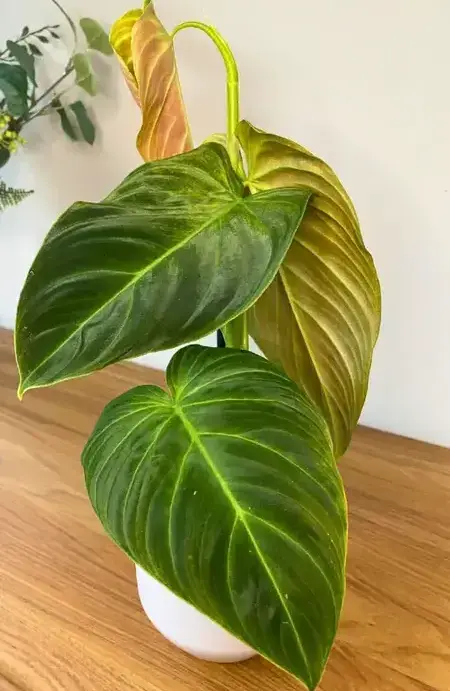
Repotting Guide
Follow these step-by-step instructions for a successful repotting experience:
- Select a new pot that’s approximately 2 inches larger in diameter than the current one. Ensure the new pot has good drainage. Prepare your fresh potting mix, keeping in mind the plant’s preference for well-draining, nutrient-rich soil.
- Water your Philodendron Melanochrysum a day before repotting to loosen the root ball. Carefully remove it from the current pot, trying your best to minimize root damage.
- Take a moment to inspect the root system. Trim away any dead, rotten, or overly tangled roots.
- Add some of your fresh potting mix into the new pot and position your plant so that the top of the root ball is about an inch below the rim of the pot. This will prevent water from spilling over when you water the plant.
- Gradually add more soil around the roots, gently tamping down the mix to remove any air pockets until the roots are fully covered and the plant is secure.
- Water the plant thoroughly and place it in a location with indirect light. Avoid fertilizing for a few weeks to allow the plant to adjust to its new environment.

Philodendron Melanochrysum Propagation
Philodendron Melanochrysum can easily be propagated via stem cuttings and air layering methods with high success rate.
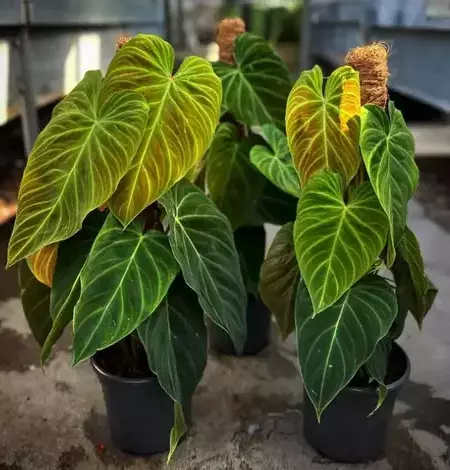
Stem Cutting Propagation
I prefer stem-cutting propagation for this climbing philodendron as this is simple and has a high success rate. As the leaves are enormous, single-node cuts are just fine for propagation.
Follow a step-by-step guide for Philodendrons Melanochrysum propagation via stem cutting.
Propagation in Water
You can put your Philodendron Melanochrysum cutting in water to propagate if it has minimal aerial roots. However the cutting takes relatively long time to root in water.
Propagation in Sphagnum Moss and Potting soil
You can also use sphagnum moss and aroid potting mix for rooting your cuttings. I prefer using sphagnum moss for cuttings that have a little bit of roots and potting mix directly if they already have a lot of roots.
Before putting your cuttings in sphagnum moss or potting mix, you might need to seal the edge of your cutting by applying cinnamon powder, anti-fungal powder, or activated charcoal to prevent rotting.
Choose a small plastic pot, put the Melanochrysum’s cutting in it, and cover the node with a little potting mix. You don’t want to bury the node too much in the potting mix as it will increase the incidence of over-watering.

Fertilizing
Like many rainforest natives, the Philodendron black gold enjoys a nutrient-rich environment to truly flourish. Although not absolutely necessary, regular fertilizing can help recreate this environment, encouraging vibrant growth and a more robust plant.
As a rule of thumb, fertilize your Melanochrysum during its active growing season, typically from spring through summer. A monthly application is generally sufficient, though you may opt for a bi-weekly schedule depending on how your plant responds. During the fall and winter months, the plant’s growth slows, and it requires less nutrition, so you can decrease the frequency or stop fertilizing altogether.
The Melanochrysum isn’t particularly picky when it comes to fertilizers, but it does best with a balanced, water-soluble houseplant fertilizer. Look for a product with an even ratio of nitrogen, phosphorous, and potassium (such as a 20-20-20) for all-around plant health. Follow the package instructions for dilution rates, and apply the fertilizer to damp soil to avoid root burn.
Here are some good fertilizers for your Philodendron available on the market:
- Philodendron Plant Food, Indoor Plant Food Liquid Fertilizer
- Liqui-Dirt Nano Powder All-Purpose Organic Plant Food
- Osmocote Smart-Release Plant Food
Over-fertilization can lead to salt build-up in the soil, which can cause leaf burn, root damage, and even plant death. Symptoms of over-fertilization include browning leaf tips and margins, yellowing older leaves, and poor overall growth. If you suspect over-fertilization, flush the soil thoroughly with clean water to remove excess salts.
Conversely, under-fertilization can cause slow growth, yellowing leaves, and lack of vigor. Remember, though, that it’s better to stumble on the side of under-fertilizing. You can always add more nutrients, but removing them from the soil can be more challenging.
Finally, it’s important to read and follow the instructions on the fertilizer package carefully. Different fertilizers have different instructions, so use the correct amount and feed your plant the right amount at the right frequency.

Pruning and Maintenance
The black gold, in all its verdant glory, requires a moderate level of upkeep to ensure it maintains its radiant appearance and health. Regular maintenance primarily consists of cleaning and occasional pruning.
Cleaning the leaves of your Melanochrysum serves a dual purpose: not only does it enhance the aesthetic appeal of your plant, but it also promotes healthier growth by ensuring the leaves can effectively photosynthesize. To clean, gently wipe the leaves with a damp cloth or sponge to remove dust.
Regularly checking the leaves, stems, and soil for irregularities ensures swift action, preventing potential issues from escalating and preserving the plant’s radiant vitality. This can be done every few weeks, or as needed, based on your indoor environment.
Pruning, though not a constant necessity, can help maintain your Philodendron Melanochrysum’s size and shape, especially if it’s starting to outgrow its space. Pruning can also be used to stimulate bushier growth by removing leggy or elongated stems.
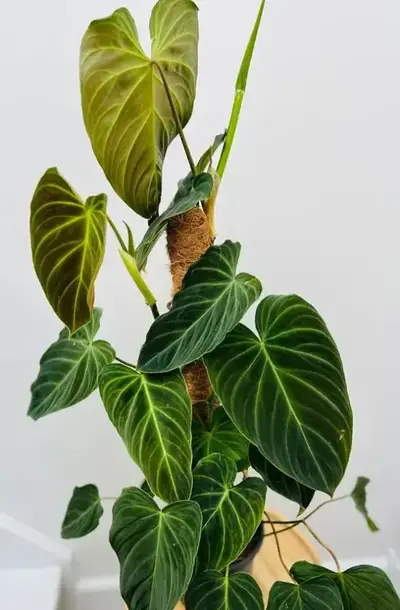
As a vining plant, the Philodendron Melanochrysum may require occasional support and training to maintain its desired shape and prevent unruly growth. Gentle guiding of the vines along a trellis or support structure encourages a more orderly growth pattern. This practice enhances the plant’s visual appeal, promotes better airflow, and reduces the risk of entanglement or damage.

Toxicity
Like many of its Philodendron counterparts, this plant also contains calcium oxalate crystals, a compound that can be toxic to both humans and pets when ingested or even touched in some cases. These crystals can cause a host of symptoms ranging from mildly unpleasant to severely distressing.
In humans, chewing or swallowing parts of the plant can lead to a burning sensation in the mouth and throat, difficulty swallowing, and nausea. Touching the plant may cause skin irritation in sensitive individuals, though this is less common.
For pets such as cats and dogs, symptoms of ingestion can be more severe and include drooling, vomiting, pawing at the face or mouth, loss of appetite, and in severe cases, difficulty breathing. If you suspect your pet has ingested any part of the plant, it’s crucial to seek veterinary attention immediately.
Because of its toxicity, it’s advisable to place your Philodendron Melanochrysum in a location out of reach from curious pets or children. If you or a family member are exposed to the plant’s sap, often through a break in the leaf or stem—wash the affected area with soap and water and seek medical advice if symptoms persist.

Diseases
Fungal diseases, often resulting from overwatering or poor ventilation, can also affect the Philodendron Melanochrysum. Root rot is a common disease that can apparent as yellowing or wilting leaves and a stale smell from the potting soil.
To treat root rot, remove the plant from its pot, trim away the affected roots, and repot in fresh, well-draining soil. Be sure to sterilize your pruning shears before and after use to prevent the spread of the disease.
Pests
The most common pests to plague the Philodendron Melanochrysum are spider mites, mealybugs, aphids, and scale insects. These pests can be detected by their visual presence or by signs such as yellowing leaves, sticky residue, or a general decline in plant health.
To counter these pests, try wiping the plant with a soft cloth dipped in a solution of water and mild dish soap, or apply an insecticidal soap or neem oil spray, following the package instructions. In severe cases, you might have to prune heavily infested leaves or even consider using a more potent pesticide.
Common Problems
Leaf yellowing can be a common problem with Melanochrysum, often a sign of overwatering or poor lighting conditions. Adjust your watering schedule and make sure the plant is receiving bright, indirect light.
Another issue that may arise is leaf browning, which is typically a result of low humidity levels. To rectify this, try increasing humidity through the methods mentioned above.
In general, providing your Philodendron Melanochrysum with the right care and conditions will go a long way in preventing most of these problems. Regularly inspect your plant for signs of pests or disease, and act promptly at the first sign of trouble. Remember, a healthy plant is often the best defense against pests and diseases.

Common Queries
Is Philodendron Melanochrysum hard to grow?
Growing a Melanochrysum can be moderately challenging, especially for those new to plant care. These plants have specific needs to mirror their native rainforest environment, including high humidity, bright but indirect light, and a well-draining soil mixture.
Though they are not the easiest plants to care for, with attention and consistency, it’s entirely possible to grow black gold successfully. They can be incredibly rewarding for the patient and dedicated gardener, with their lush, velvety leaves and vigorous growth habit making them a standout addition to any indoor plant collection.
Remember that like all plants, the Philodendron Melanochrysum will take time to adapt to its new environment, and its care needs may change depending on conditions such as light levels, temperature, and humidity. Regular monitoring and adjustments to its care routine will help ensure it thrives.
Is Philodendron Melanochrysum slow grower?
Although Philodendron Melanochrysum grows slowly, the wait is worthwhile because it eventually develops a robust stem capable of supporting its sizable leaves.
How do you get big leaves in Melanochrysum?
To promote luxuriant and vibrant foliage, the Melano plant thrives in environments with high humidity and bright indirect light. I would say never underestimate the power of good lightning for growing bigger leaves. Supplement your Melanochrysum with good growing lights to produce biggers and lush leaves. Plus, maintaining humidity levels above 60-80% ensures optimal growth. Although the Philodendron Melanochrysum can tolerate slightly lower humidity, but moderate humidity results in smaller leaves and slightly duller coloration.
Does Philodendron Melanochrysum need a moss pole?
As Philodendron Melanochrysum grows and matures, it tends to grow like a vine and seeks assistance to a support structure such as a janky sticks or moss pole to climb. By providing a sturdy support, you can help to prevent plant’s stems and leaves from becoming tangled or damaged. Moreover, using moss pole will help your Melanochrysum grow bigger leaves.
Can Melanochrysum get too much sun?
Direct sunlight should be avoided for the Melanochrysum plant as it can cause leaf burn. Interestingly, I have observed that my indoor plants rarely experience sunburn, even when placed near sunny windows.
Why are my Melanochrysum leaves so small?
If you find that the leaves of your Philodendron Melanochrysum are smaller than expected, it could indicate under-fertilization. Ensuring an adequate supply of nutrients is crucial for the plant to flourish and produce larger leaves.
Should I mist my Melanochrysum?
Misting your Melanochrysum is highly recommended! It serves as an effective method to elevate the humidity levels surrounding the plant and provide additional moisture. This practice becomes particularly vital during the summer season when the plant is in its active growth phase, producing new leaves.

Conclusion
The Philodendron Melanochrysum, with its striking velvety foliage and captivating growth habit, makes a resplendent addition to any indoor jungle. Its exotic allure lies not only in its visual appeal, but also in the journey one embarks upon while catering to its needs.
This plant hails from the rich, tropical rainforests of South America, and thus, craves environments that echo its natural habitat. High humidity levels, warm consistent temperatures, and bright, indirect light form the backbone of its care requirements. The plant thrives in well-draining, nutrient-rich soil and appreciates regular, balanced fertilization. Vigilant monitoring of its watering needs, coupled with proactive pest and disease management, goes a long way in maintaining its health. While it’s imperative to remember the plant’s toxic nature, cautious placement can circumvent any potential issues.
In crux, the black gold, despite its difficult care requirements, generously rewards its caretaker with an entrancing display of tropical beauty. It remains a testament to the marvels of nature, an emblem of the enchanting, verdant world from which it originates. In tendering to its needs, one forms an intimate connection with this piece of the tropics, and in return, the Melanochrysum flourishes, filling its surroundings with an unmatched botanical charm.
Related Posts
Alocasia Azlanii ( Jewel Alocasia) | Red Mambo Plant Care
Did you know Alocasia Azlanii is a relatively new and world’s most sought-after jewel Alocasia due to its compact size and spectacular metallic foliage
Alocasia Odora | Elephant Ear Plant Care Tips
Alocasia Odora is also named Elephant ear because of its paddle-shaped and colossal leaves. It got the nickname Night-Scented Lily due to fragrant blooms.
Alocasia Longiloba | Watsoniana, Grandis, Veitchii & Longiloba Siver Care
Alocasia Longiloba is a tropical, tuberous flowering plant, another astonishing member of the Araceae family, to give a tropical feel to a garden or indoors.
Alocasia ‘Frydek’ | Green Velvet Alocasia Care Tips
Alocasia Frydek is an astounding and breathtaking member of the Alocasia family, also known as Green Velvet Alocasia.
Alocasia Zebrina | Reticulata,Variegata & Zebrina Tiger Care Guide
The Alocasia Zebrina is a tropical ornamental plant in the family Araceae. It is native to tropical and subtropical regions of Southeast Asia,

